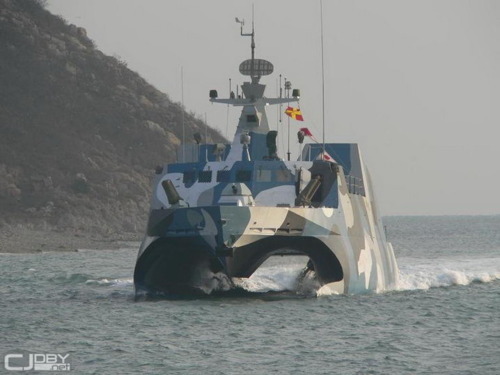East Asia Intel:
Below- the Chinese PLAN Navy’s Type 022

A senior military commander disclosed last week that the U.S. military is quietly developing a new war strategy to counter China’s expanding military and its deployment of weapons systems designed to limit U.S. military movements and defenses in Asia.
Adm. Robert Willard, head of the U.S. Pacific Command, said he is excited about what is being called the AirSea Battle Concept that was ordered in 2009 by Defense Secretary Robert M. Gates to bolster military forces in the Pacific.
The concept, which is still being developed, grew out of several war games that showed U.S. forces, primarily Navy and Air Forces systems, were ill-equipped to challenge Chinese forces if a conflict erupted over Taiwan or other Asian hotspots.
“This is a natural evolution, progression for us, as we advance our military capabilities, and I think it will only enhance the capabilities that we present to this region, the Asia Pacific, within U.S. Pacific Command,” Willard said after a speech in Washington.
The battle concept calls for a broad range of steps to better coordinate the Air Force and the Navy in the Pacific, said defense officials close to the study. The plans include better joint communications and integrated attack and defense strategies.
Officials said the plan responds to China’s “anti-access” strategy of using ballistic and cruise missiles, submarines and aircraft to drive U.S. forces out of the western Pacific or limit them in aiding U.S. allies.

Most of this is in reaction to the Chinese (ex-USSR) Kent, Sunburn Missile which is acruise anti ship missile which is a Mach 2+ ship killer, and the C(D)F-21 1st of kind (if it works) ballistic anti carrier missile. The purpose of these missiles is to deny operational area to US forces. US Navy doctrine says the following:
“In a conflict, the U.S. Aegis destroyers and cruisers that accompany aircraft carriers could be used to foil anti-ship missiles with SM-3 interceptor rockets, experts say. Interceptor capacity on Aegis-equipped ships isn’t enough to reliably defend against a volley of well-placed anti-ship ballistic missiles.”
Asked about China’s new ballistic missile that is designed to kill aircraft carriers, Willard said the U.S. military’s forward presence in Asia remains strong.
“AirSea Battle [Concept] has many aspects to it. I’m excited about the prospects of achieving more out of these two services than we’ve been able to achieve in the past,” he said.
“We’ve since integrated [the] Marine Corps into the study and their capabilities, and at the end of the day, this will be an enhancement to our joint force writ large,” he said.
One defense official said later that the Marine Corps was added to the AirSea Battle Concept amid growing assertiveness by China’s military. The concept will call for potentially using Marines in sensitive scenarios, such as ejecting Chinese forces from disputed islands in the East China or South China seas.
“The Japanese and South China Sea states don’t have Marine Corps-type capabilities to stop a Chinese occupation of islands, a U.S. Marine Corps specialty for 80 years,” the official said.
Adding Marines to U.S. battle plans is likely to upset China, whose military researchers have criticized the Marines as U.S. shock troops for imperial aims.
The concept will give the Marines a new role in Asian Pacific strategy.
In recent months, China’s military has triggered alarm in the East China Sea by pressuring Japan to release a Chinese fishing boat captain caught illegally fishing near the Senkaku Islands.
WE CALL THEM THE PINNACLE ISLANDS

It also has taken assertive military steps in the South China Sea, claiming the entire region as its economic zone and last year planting a Chinese flag on the sea floor with a miniature submarine.The battle plan calls for more war games against simulated Chinese forces, something limited in the past by political officials who feared such exercises would artificially create a new Chinese military threat.
However, the military in recent years has grown sufficiently concerned about China’s military buildup and failure to cooperate with the U.S. military to change its posture in Asia.
No comments:
Post a Comment